I visit Tando Allahyar every year to celebrate Eid with my family. When I was young, I used to be able to go out on the streets without a care in the world. Now that I’m older, I can’t leave the house without a distinct purpose and a chaadar wrapped around my body. When my grandmother told me that the Hindus of the village were having a three-day mela (fair) beginning on the eve of Eid, I grabbed my thick embroidered chaadar, awkwardly wrapped it around myself and begged my dad to escort me.
Women do not occupy any kind of public place in Tando Allahyar, which is why the sight at the Rama Pir ground was so interesting.
During Eid this year, Tando Allahyar was remembering a 19th century Hindu saint. The biggest three-day festival in reverence to Ramdev Pir, or Rama Pir, had people coming into Tando Allahyar from all over Sindh.
What I found in those narrow streets is completely contradictory to the extremist narratives that shadow the cities and towns of Pakistan.
In that small neighbourhood, I expected to find a bunch of different religious and ethnic communities who would serve as a model for religious tolerance. Instead, I found a single community which exuded religious acceptance. It was a matrimonial rarity.
The streets were adorned with lights. Luminescent bulbs danced in the sky as jubilant people moved to rhythmic chants. Every corner of the neighbourhood was alight with celebration.
This was a different Pakistan. A part of me winced as I realised that this festival was tucked away in the outskirts, somewhere it would barely get noticed.
The streets were bustling with joyous young men on motorbikes and little children with rainbow coloured mithai (sweets).
But what made the streets really come alive were the women.
They were wrapped in bright saris, beaded in shiny sequins and drenched in gold. Most of the women had their faces covered. The pallus of their saris draped their heads and fell across their faces. In the shadow of their pallus, they chatted, laughed, tried on chooriyan (bangles) made of glitter and furiously haggled with the vendors. Their arms were covered with rings of thick white bangles yet their movement was fluid. They glided through the crowds of men with effortless grace. They were careful and nonchalant at the same time. I was mesmerised. I caught glimpses of their faces when their hands would slip and the cascade of pallus parted by accident. Their faces were painted with beads of gold that went across their foreheads, hugging the arches of their eyebrows. The glint of their sparkling nose rings enslaved my gaze. I could not look away. I was in love.
Their shine was only eclipsed by the husbands, fathers and brothers who kept a stern eye and directed their movements. Many of the women did not want to be photographed because their husbands did not approve. They did not want to be approached or talked to. When I tried to start a conversation with some of the women, their pallus tightened and their eyes furtively moved in the directions of the men. Man or woman, talking to strangers made them nervous.
The festival includes hundreds of different vendors in the bazaar who were selling clay pots, plain and glittered, mounds of rich, colourful mithai and chooriyan. So many chooriyan. It was a bazaar made for women. It also included fun activities for the children. There was a big Ferris wheel, small pirate ships and various other rides for them to enjoy. Moreover, the festival also constitutes a performance by the Lucky Irani circus group. Jugglers and flame-eaters kept the audience entranced and the travelling zoo had the children going wild with glee. The sight of an elephant in interior Sindh is no ordinary thing.
The Rama Pir temple was swarming with people.
I took off my shoes and made my way to one of the windows to take a peek at the ceremony that was taking place inside. All I could see were the heads of the devotees swaying with the chants. Small puffs of incense smoke twisted and curled around them. Some of it found its way to my nostrils and I inhaled their passion. Their love reverberated through my bones and my heart felt heavy with an emotion I could not understand. I was elated to see the Hindu community so absorbed in religious fervour. My chest rose in pride to see that religious freedom has not been stamped out of the streets of Pakistan. But I felt a tinge of pain at the thought of how much the Hindu community has suffered in this country.
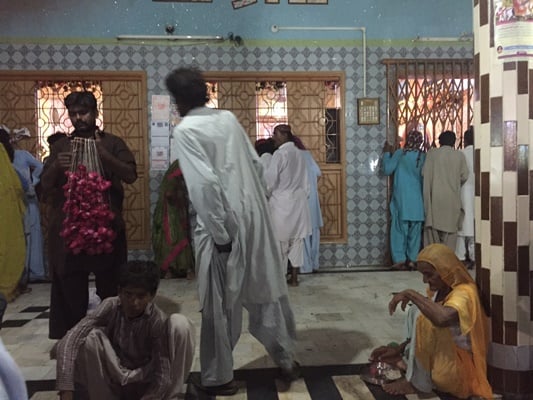 Photo: Aseela Haque
Photo: Aseela Haque Photo: Aseela Haque
Photo: Aseela HaqueThe national narrative that has developed within these 67 years has completely excised Hindus. The process of exclusion began to develop the ideology of Pakistan and give it an Islamic hue. The Pakistani identity has been purposefully drowned in Islamic rhetoric. It is, after all, in the name of Islam that fateful lines were drawn on a map.
It is easy to get absorbed into the narrative when you’re the majority. You represent the ‘green’ in your flag so the ‘white’ just fades into the background.
It is easy to buy into the claim that Pakistan is the land of the Muslims, the land of the pure.
The truth is that you and I have swallowed our history books whole. We have lapped up every page, down to the last word.
It’s time we regurgitate some of that out.
The fact is that the Hindus have a very old connection to Sindh. Their shrines and mandirs are much older than many mosques. I’m not saying that claims that state Muslims have an inherent connection to the land are false. It’s just that Muslims aren’t the only ones with deep-rooted historical bonds to Sindh, or all of Pakistan for that matter.
In Balochistan, the Hinglaj Mata Temple is a site of pilgrimage for Hindus all over Pakistan. The pilgrimage experience is described as “death or darshan”. The journey from Karachi takes 45 days through the harsh dessert terrain. People engage with the land during their journey and perform various rituals and rites.
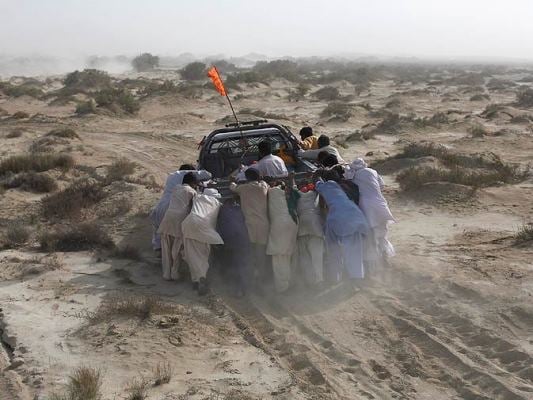 Devotees push a vehicle stranded in desert while visiting Shri Hinglaj Mata Temple.Photo: Reuters
Devotees push a vehicle stranded in desert while visiting Shri Hinglaj Mata Temple.Photo: Reuters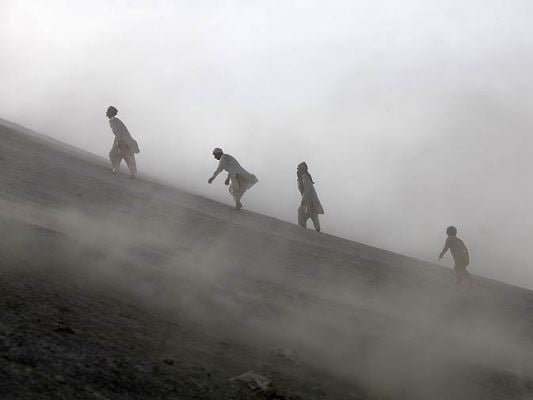 Devotees climb a mud volcano to perform a ritual.Photo: Reuters
Devotees climb a mud volcano to perform a ritual.Photo: Reuters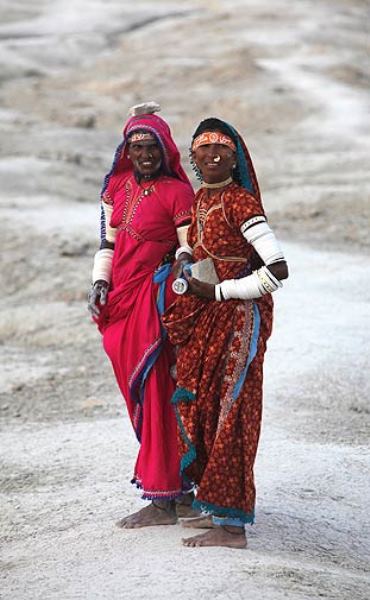 Devotees carry dry mud collected from a mud volcano, which is sacred to them.Photo: Reuters
Devotees carry dry mud collected from a mud volcano, which is sacred to them.Photo: Reuters A devotee receives blessings in front of the deity at the Shri Hinglaj Mata Temple.Photo: Reuters
A devotee receives blessings in front of the deity at the Shri Hinglaj Mata Temple.Photo: ReutersMoreover, the Rama Pir temple in Tando Allahyar, was built around 206 years ago. It stands today where Ramadev Pir is said to have sat. This is why Tando Allahyar holds religious significance for the Hindus. It is the land touched by their saint.
The festival takes place every year with tremendous support from the Muslim community. Many Muslims take part in the festivities. Muhammad Furqan Khan, a resident of Tando Allahyar, recalls going to the mela in his childhood,
“I loved the circus. Especially the animals. They used to have a lion. I remember feeling excited and scared the first time I saw it.”
He adds that,
“The Muslims have never objected to the ceremonies and festivities. Nobody has ever tried to stop the processions. The two communities have a lot of respect for each other. The pilgrimage brings in good business to the shopkeepers and vendors. There is no religious divide.”
Khan’s words are reflected in the fact that policemen were stationed at various places in the bazaar, mela and outside the mandir. The presence of the policemen indicated the support and protection of the state. It warmed my heart to see that the people of Tando Allahyar have taken real ownership of the Hindu community.
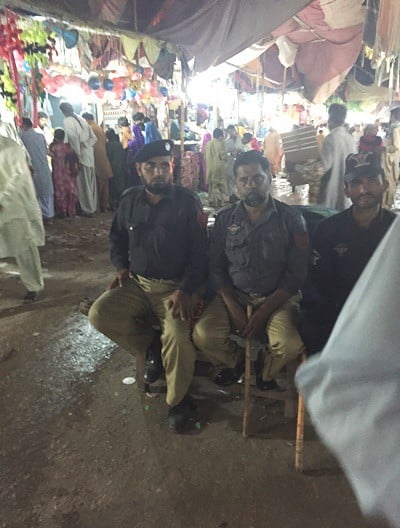 Photo: Aseela Haque
Photo: Aseela HaqueIt was extraordinary to see Eid and the Rama Pir festival being celebrated at the same time with such earnest enthusiasm. Animals were slaughtered, deities were worshipped, women were out on the streets, and qurbaani meat and prasad were sought after.
At my family Eid barbecue, mutton was being spiced and grilled. A delicious tamarind sauce was being ladled and tasted. Fresh naan was being doled out of polythene bags. The smell of kebabs and botis hung in the air, along with the undeniable aroma of incense.



COMMENTS
Comments are moderated and generally will be posted if they are on-topic and not abusive.
For more information, please see our Comments FAQ